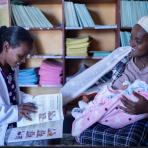By Dr. Dilantha Dharmagunawardene1, Prof. Reece Hinchcliff1, Prof. David Greenfield2, Dr. Mark Avery1 and Ms. Paula Bowman3
- Department of Management, Griffith Business School, Griffith University
- School of Population Health, University of New South Wales
- School of Public Health and Social Work, Faculty of Health, Queensland University of Technology
Background
There are approximately 134 million adverse events and 26 million deaths in Low- and Middle-Income Countries (LMICs) hospitals each year. This immense burden is due to poor quality and patient safety systems. Hospital accreditation programs have been recognized as an important strategy to improve quality and patient safety. However, many programs in LMICs start with a bright spark, but without fuel—political, financial, and local—those flames fade fast, raising key concerns.
Hospital accreditation programs are expensive to establish and implement, often requiring initial funding from international donor agencies, and technical assistance from the World Health Organization (WHO), International Society for Quality in Health Care (ISQua) and other groups. Discontinuation of programs following the resource intensive start-up phase creates considerable wastage in already resource-constrained LMIC settings. Rates of program discontinuation are likely to increase due to recent decisions by United States Administration to reduce financial support of donor agencies, including US Agency for International Development’s (USAID) and World Health Organization.
Of course, program discontinuations are not purely a financial issue. The first author personally experienced the dilemmas associated with failed accreditation systems, as in the case of Sri Lanka Hospital Accreditation Program, which was commenced in 2015 and discontinued in 2019. This failed initiative had generated tremendous enthusiasm and engagement from multiple stakeholders at inception, but ultimately ceased due to preventable issues, such as frequent turnover of leadership positions. The discontinuation also reinforced a sense of change fatigue and general cynicism of macro quality and safety reforms among key stakeholders, impeding future endeavours.
Discontinued hospital accreditation programs in LMICs are a waste of resources, a lost opportunity to save lives of people harmed through healthcare, and a demotivator of involved stakeholders. This makes it vital to better understand factors that not only cause discontinuation, but also those which can facilitate sustainable implementation.
Our recent scoping review in Health Policy and Planning summarised and appraised published evidence on factors affecting the establishment of hospital accreditation programs in LMICs, using a novel ACES-GLEAM Analytic Framework, integrating complex and inter-related factors related to the trajectory of accreditation program establishment. The study aimed to provide insights to guide the hospital accreditation endeavours of global stakeholders establishing sustainable and effective accreditation programs in LMICs.
What we found
Due to technical, resources and capacity limitations, most hospital accreditation programs in LMICs were initiated with technical and financial assistance from global accreditation and donor agencies using project-based approaches. However, as also exemplified by many other large-scale, externally funded health programs in LMICs, this increased the likelihood of discontinuation once external assistance ceased at the end of the project period. This was mainly due to inadequate attention to local capacity development by both external and internal stakeholders, leading to poor sustainability.
Moreover, international stakeholders have tried to enforce accreditation initiatives on health systems and structures of LMICs, already weakened due to crises such as civil war or epidemics. Their intention, naively, was to use hospital accreditation programs to strengthen these weakened systems and to improve quality and patient safety. Usually, as our research shows, this has been a futile approach, as establishment of sustainable hospital accreditation programs is a complex and resource-intensive endeavour, requiring long-term planning, multi-stakeholder involvement and a gradual, stepwise approach.
The scoping review also revealed the following characteristic features that needs to be meticulously balanced in accreditation program establishment in LMICs to ensure sustainability.
- Governance – Dependence on government mandate of accreditation programs should be balanced to minimize undue influences and interference due to bureaucratization. However, independence from government has led to poor coverage, poor credibility and resource constraints.
- Standards – More attention to process and outcome accreditation standards has resulted in demotivation of health staff, as they cannot achieve outcomes without resources (structures). In contrast, less attention to process and outcome standards reduces attention on continuous quality improvement, which is one of the main objectives of accreditation programs. Additionally, attempts to develop locally contextualized standards led to increased time requirements to establishment, while adoption of external standards resulted in contextual mismatch with local needs.
- Surveyors – Employment of locally available surveyors can lead to subjectivity and peer pressures in assessment, but they are important for contextually relevant and low-cost assessment processes. Comparatively, external surveyors bring more objectivity to assessments and their international exposure is important for local capacity development, despite the high cost.
- Stimulants (Incentives) – Availability of monetary stimulants have resulted in opportunistic behaviours among stakeholders diverting from the primary objective of continuous quality improvement, but they are important contributors to motivate stakeholders to participate in accreditation endeavours.
- Survey Execution – Mandatory implementation of accreditation programs led to opportunistic behaviours but resulted in higher coverage of accredited hospitals compared to the voluntary accreditation programs.
This scoping review has identified some innovative features among accreditation programs in LMICs, which can be benchmarked by other programs to ensure effectiveness and sustainability.
- Systematic, collaborative, and participatory approaches to standards development
- Induction training and continuous professional development of surveyors
- Integration with social insurance systems as monetary stimulants (incentives) in combination with non-monetary stimulants (incentives) such as recognition, branding and promoting public awareness
- Pre-survey capacity development programs for hospital staff focusing on continuous quality improvement
- Utilization of information and communication technologies for survey management and survey execution to ensure smooth implementation processes
- Step-wise implementation of accreditation programs to enhance staff motivation in resource constrained settings.
The most important enablers identified in the scoping review were internal support within the national level systems, clearly defined entities, responsibilities and functions of the accreditation agency, and external support from international entities. Resource inadequacy in terms of human and financial resources were the main reported barrier.
Conclusions
This scoping review has mapped and critically analysed the key challenges, patterns, balancing features, innovations, enablers and barriers in the establishment of accreditation programs of LMICs. Therefore, national and international level stakeholders who are involved in accreditation programs establishment in LMICs are encouraged to consider these identified factors to have sustainable and effective accreditation programs in LMICs. Many of the key findings are also equally relevant to other, non-accreditation, national quality and safety reforms in LMICs, particularly in the current geopolitical climate of reduced funding for international aid and development.











